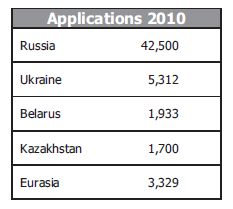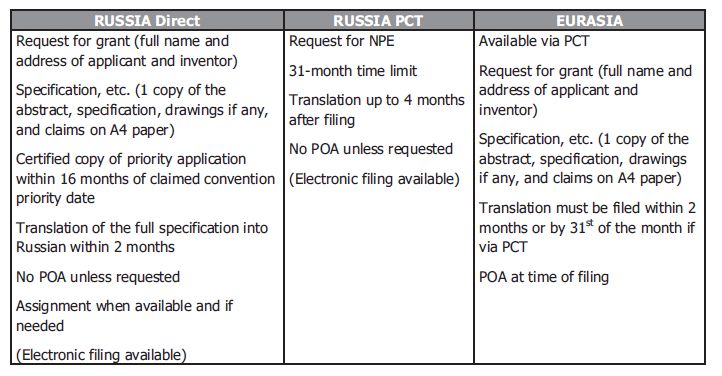Businesses operate globally, sell products internationally and reach consumers in every time zone. Intellectual property portfolio management decisions, however, are very much based on jurisdiction. Gowlings has operated in Russia and the CIS for over 20 years, working with clients to determine the intellectual property strategies that work best for them. The following article outlines considerations for filing in this part of the world.
In the Russian Federation, CIS member states and in the Ukraine, a patent may be obtained directly under a country's national laws. For example, a Russian patent is granted by ROSPATENT. For some countries, including Russia, the alternative is to seek patent protection through the Eurasian Patent Office (EAPO) for coverage in all of its member states: Russia, Kazakhstan, Belarus, Azerbaijan, Armenia, Kyrgyzstan, Moldova, Tajikistan and Turkmenistan. Ukraine, Georgia and Uzbekistan are not part of the EAPO.
The overwhelming majority of applications are direct-filed in Russia, in Ukraine, Kazakhstan and Belarus. For example, in 2010 new applications filed were as follows:

Whether it is a direct-filed application in Russia, Ukraine, in a CIS country or a national phase entry filing through the Patent Cooperation Treaty (PCT), or an EAPO-filed application, an issued patent has a term of 20 years from its filing date. In Russia, patents are granted by ROSPATENT for inventions, utility models and industrial designs but only patents for inventions may be obtained via PCT and EAPO filings.
Under the EAPO regime, a successful applicant receives the grant of a Eurasian patent, which is valid in all contracting states. Issued Eurasian patents accord rights that are effectively equivalent in scope to individual patents that would otherwise be granted on a national level in each contracting state.
Prosecution: Determining the Right Strategy
The following chart illustrates the key components of filing under the three main methods.

When filing a Eurasian application, all contracting states are automatically designated. It means an applicant is not able, at this stage, to seek patent protection in only some of the contracting states. The first opportunity to narrow down the territories is at the time of grant when the first annuities are due to be paid. If the annuity for a certain country is not paid, the patent is abandoned in that country.
Subject Matter, Novelty and Patentability: Russia
To be patentable, the subject matter of an invention (Article 1350) must be a technical solution in any area related to a product or a means. A product includes a structure, substance, microorganism strain, or culture of cells of plants or animals. A means is a process of conducting actions on a material object with help of material means.
An invention is patentable (Article 1350(1)) if it is new, has an inventive level and is industrially applicable, i.e., if it is novel, unobvious and useful.
"New" means that it is not known from the level of technology (Article 1350(2)). The level of technology includes any information that became generally accessible in the world before the priority date of the invention. It also includes previously filed applications in Russia with an earlier priority date that are subsequently published within 18 months under Article 1385(2).
"Inventive level" means that, for a specialist, it does not obviously follow from the level of technology (Article 1350(2)).
"Industrially applicable" means that it can be used in industry, agriculture, health care, or other branches of the economy, or the social sphere (Article 1350(4))
There is an "absolute novelty" requirement with a six-month grace period associated with the prior disclosure of the invention by the inventor, so long as the actual filing date of the application in ROSPATENT, and not the priority date, is no more than six months from the date of that disclosure by the inventor (Article 1350(3)).
Subject Matter, Novelty and Patentability: In the EAPO
While the procedural and substantive requirements for applications filed in the EAPO strongly resemble those for applications filed directly in Russia, they are not, in literal terms, the same.
There is no definition or list of criteria for eligible subject matter. The Patent Regulations of the Eurasian Patent Convention (EPC) stipulate a Eurasian patent shall be granted for any invention that is novel, involves an inventive step and is industrially applicable (Rule 3(1)).
"Novel" means that it is not anticipated by prior art. Items of prior art may only be taken into account separately for the purpose of determining novelty.
"Prior art" is any kind of information made available in the world before the date of filing of the Eurasian application or, where priority is claimed, before the priority date of the application. It can also include a co-pending application having an earlier filing/priority date if that application is subsequently published.
"Inventive step" means that it is not obvious to a person skilled in the art.
"Industrially applicable" means that it can be used in industry, agriculture, public health or other fields of human activity.
There is an "absolute novelty" requirement with a six-month grace period as there is in Russia. However the six-month grace period is defined as: information relating to the subject matter of the invention that has been made available to the public not earlier than during the six months preceding the filing date of, or the priority date claimed for, the Eurasian application, by the inventor or applicant or by any person having obtained the information directly or indirectly from them (Rule 3(2)).
Examination
A few other differences to note include examination and office actions. In Russia, examination may be deferred for up to three years, but in the EAPO, examination must be requested at the time of filing. With regards to office actions in Russia, a response to an office action is typically due within two months from the date of receipt, which is deemed to be no longer than four months from the date of issuance. One 10-month extension is possible. In the EAPO, a response is typically due within four months of issuance. Extensions of time of any length are possible.
The Eurasian Patent Office provides an easy, quick and cost effective means of obtaining patents in Russia and the CIS member states. It is a logical choice when a decision has been made to protect an invention in multiple countries forming part of the CIS. The EAPO provides a particularly advantageous means of sidestepping the patent offices of the smaller CIS countries where there is little transparency and great uncertainty with respect to practice and procedure. EAPO practice and procedure is relatively predictable, permissive and user-friendly.
On the other hand, in cases where Russia and Ukraine are the primary countries of interest, direct filing in those countries is the preferred route. Ukraine is not part of the EAPO. Moreover, in the context of a contentious invalidity challenge, it is thought the issued claims of a Russian patent are likely more robust than those of an EAPO patent.
The content of this article is intended to provide a general guide to the subject matter. Specialist advice should be sought about your specific circumstances.
